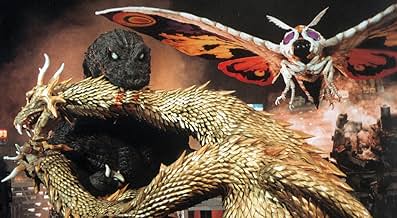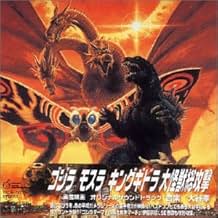Godzilla, Mothra et King Ghidorah
Ajouter une intrigue dans votre langueA reporter, notorious for working on pseudo-documentaries, must uncover the legend of the three guardian monsters who must rise to defend Japan from the vengeful spirits within Godzilla.A reporter, notorious for working on pseudo-documentaries, must uncover the legend of the three guardian monsters who must rise to defend Japan from the vengeful spirits within Godzilla.A reporter, notorious for working on pseudo-documentaries, must uncover the legend of the three guardian monsters who must rise to defend Japan from the vengeful spirits within Godzilla.
- Réalisation
- Scénario
- Casting principal
- Récompenses
- 1 nomination au total
- Commanding Sector officer
- (as Nobuo Kakuda)
Avis à la une
As with the original black and white, Godzilla looks the part of the monster it is - a unique hybrid not a dinosaur-age imitation or look-alike. The other monsters in this one, especially Mothra and the Red Monster look more cartoonish. The battle scenes, rampage and destruction around Tokyo again has a real feel to it.
This plot has an interesting twist. The original Godzilla was conceived as an aberration that resulted from nuclear bomb testing in the Pacific Ocean. But, in this film, a question surfaces more than once, after a reference to Godzilla having been in New York (the 1998 American film). "Why Tokyo again?" a couple of Japanese officials ask rhetorically. And the female lead, Yuri Tachibana (played by Chiharu Niiyama) says that it may be because Japan has to acknowledge its inhumane actions in the Pacific war. That's how the reference is stated regarding World War II and Japan's inhumane aspects in its conduct of the war.
Even though it doesn't specify any of the bad deeds, this is an acknowledgement that the Japanese did some heinous things during the war. That's interesting coming in a film 55 years after the end of WW II.
Le saviez-vous
- AnecdotesSuit actors Mizuho Yoshida (Godzilla) and Rie Ôta (Baragon) would frequently "roar" when inside their suits during filming. Rie Ôta also happens to be the first female suit actor in the Godzilla series.
- GaffesThe unnatural way King Ghidorah's two outer heads attach to his body, and the way they move, clearly reveal there's an actor inside his suit, and that these two heads are actually arm puppets. In other films, the heads were moved by strings, producing a much less fake-looking effect.
- Citations
SDF Adm. Taizô Tachibana: At the end of the last century, a similar monster to Godzilla attacked the United States. The existence of abnormal organisms have since been reported around the world.
Soldier one: That was Godzilla after all, right?
Soldier two: The Americans reported it as that. Our academics don't agree.
- Versions alternativesDuring the November premier, in addition to the unfinished special effects shots, the score was incomplete. It has been remixed since then.
- ConnexionsFeatured in Cinemassacre's Monster Madness: Godzilla 1998 (2008)
- Bandes originalesGodzilla Theme
Track from "Godzilla Vs. King Ghidorah" - 1991
Ending Credits Theme 1
Composed by Akira Ifukube
Meilleurs choix
Détails
- Date de sortie
- Pays d’origine
- Langue
- Aussi connu sous le nom de
- Godzilla, Mothra and King Ghidorah: Giant Monsters All-Out Attack
- Lieux de tournage
- Société de production
- Voir plus de crédits d'entreprise sur IMDbPro
Box-office
- Budget
- 9 400 000 $US (estimé)
- Montant brut mondial
- 18 623 382 $US
- Durée1 heure 45 minutes
- Couleur
- Mixage
- Rapport de forme
- 2.35 : 1
Contribuer à cette page



























